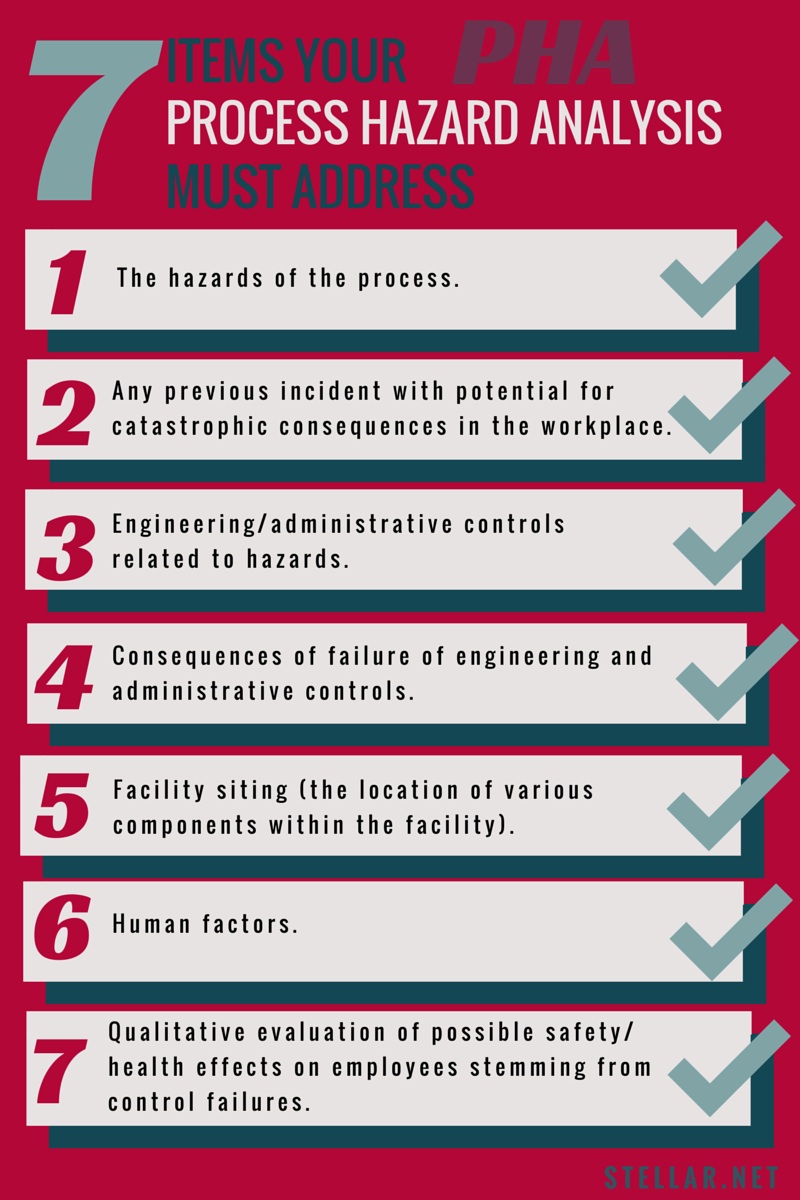A process hazard analysis (PHA) is just one of the 14 essential process safety management (PSM) elements, but it’s also one of the most important. A PHA is extremely detailed, designed to examine and address potential hazards associated with handling highly hazardous chemicals. Do you have all of your bases covered?
About PHA
Your PHA should provide information that will assist in your plant’s decision making about improving safety and reducing the consequences associated with hazardous chemicals.
A PHA analyzes potential causes and consequences of:
-
Fires
-
Explosions
-
Releases of toxic or flammable chemicals
-
Major spills of hazardous chemicals
A PHA focuses specifically on:
-
Equipment
-
Instrumentation
-
Utilities
-
Human actions
-
External factors that might affect the process
The Occupational Safety and Health Administration (OSHA) requires PHAs to be updated and revalidated every five years. However, you must update your PHA whenever you alter an item that affects your process. This could include anything from the introduction of new equipment or substances to the elimination of existing equipment or any change that could introduce a new hazard.
When your PHA is examined, an auditor takes about two days at your facility, posing questions to your plant’s refrigeration personnel and engineering teams.
The ‘what if’ methodology
With a PHA, you’re responsible for your own answers. There are a few methodologies you can use when evaluating your process hazards; however, Stellar has found that the “what if” methodology historically works best (as it is faster) for the ammonia refrigeration industry. Through the “what if” approach, “what if” questions are posed about hazard scenarios to elicit answers that show how your plant would address them.
Here’s a sample “what if” question/scenario and answer about a valve.
Question: What if the packing fails on the valve?
Answer: I have trained operators and a PM program. Personnel makes rounds each day to inspect for leaks.
7 items to address in your PHA
After you’ve determined your methodology, you should ensure your PHA addresses the following seven items outlined by OSHA:
-
The hazards of the process
-
The identification of any previous incident that had a likely potential for catastrophic consequences in the workplace
-
Engineering/administrative controls related to hazards, such as the application of detection methods for early warning of chemical releases (Acceptable detection methods might include process monitoring and control instrumentation with alarms, and detection hardware such as hydrocarbon sensors)
-
Consequences of failure of engineering and administrative controls
-
Facility siting (the location of various components within the facility)
-
Human factors
-
A qualitative evaluation covering the range of possible safety and health effects on employees stemming from control failures in the workplace

Here, I’ve touched on just a few factors of a PHA; you can learn more in the “Preventing Chemical Accidents: Introduction to Process Hazard Analysis” resource featured on OSHA’s website.
If you’d like to learn more about PHA, email me at foodforthought@stellar.net.





How can the quality of PHAs can be measured. Is there a process in place or some guidelines for checking the quality of a PHA?
Thank you.
Hi Vic,
Thanks for your comment. This can be accomplished through the auditing process from a formal 3-year compliance audit or gap analysis. OSHA has set guidelines for your PHA that must be followed; however, a good PHA would be tailored to your specific process and accurate process safety information. If you have any further questions, please feel free to contact me at rboyd@stellar.net. I’d be more than happy to help!
Thank you,
Richard Boyd
Thank you, Richard.
In my case for specific projects and specific system as we created checklists of questions that apply to those instances, but also leave a way for engineers that do the risk assessment to identify additional risks not only the checklist which is general PHA. Here I could see inconsistencies with what I expected and what I found out after I reviewed some of those completed PHA check lists. And for a check list the quality to assess it is just check if they list is completed. Just a thought.
Thank you much.